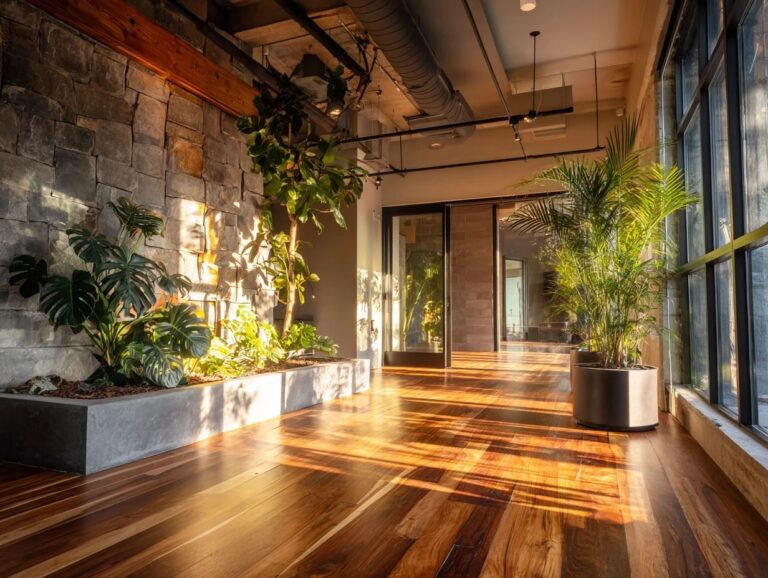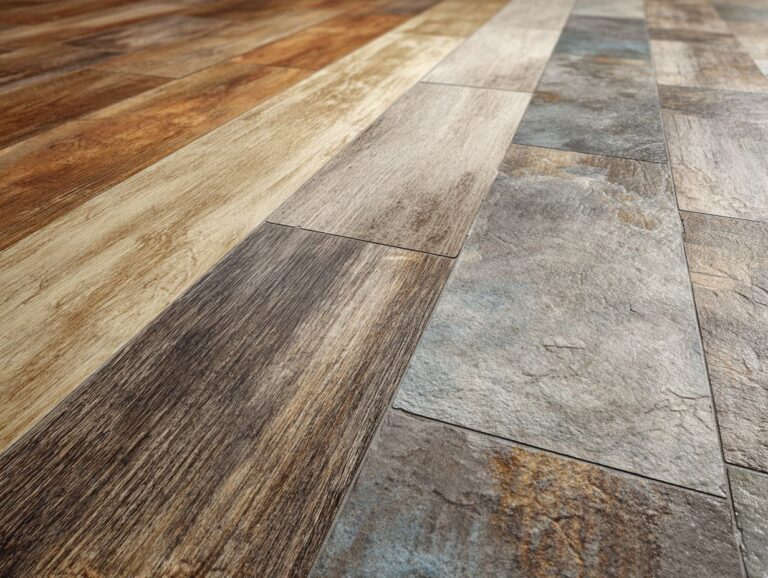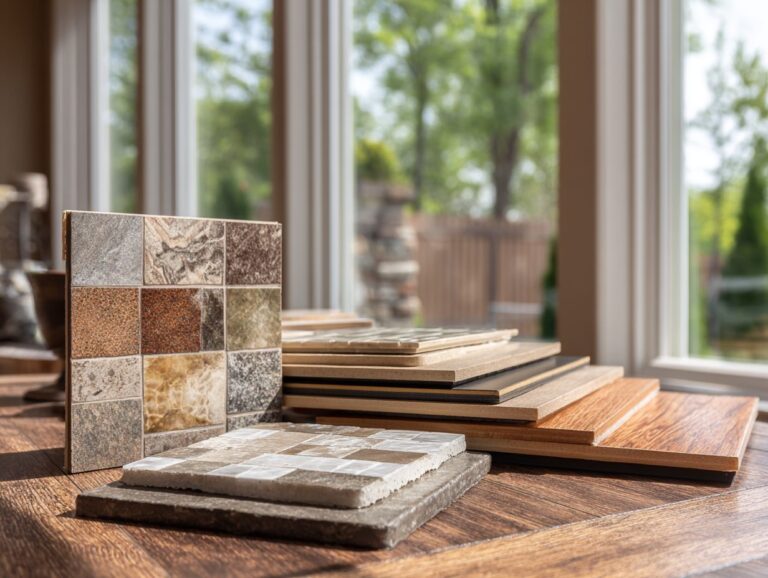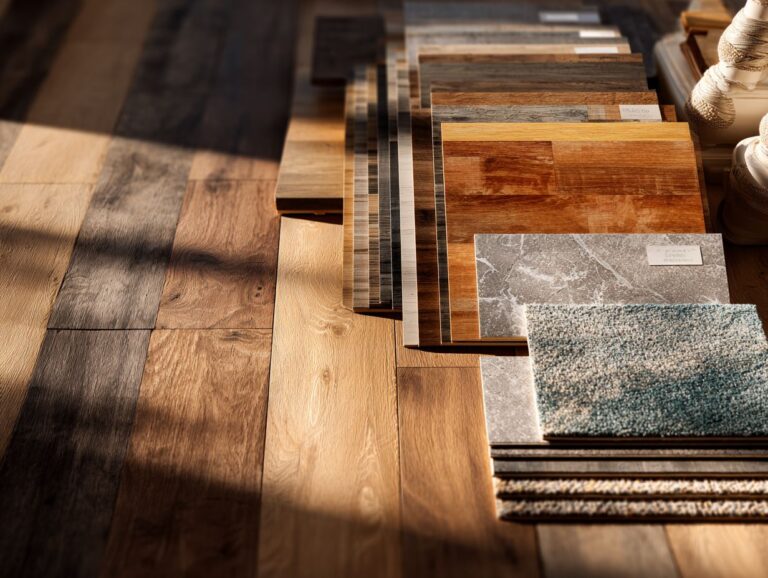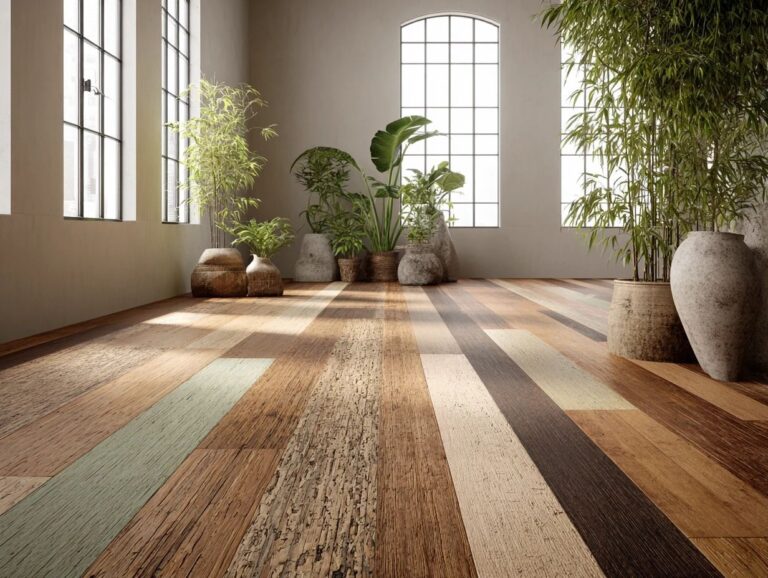DIY vs Professional Flooring Installation – Cost Analysis
Choosing between DIY flooring and professional installation can significantly impact your budget and satisfaction. Whether you’re thinking about laminate flooring or hardwood flooring, knowing the cost differences between doing it yourself and hiring a professional is important. This article will explain the costs, benefits, and important factors to help you choose flooring that improves your home without costing too much.
Key Takeaways:
Contents
- DIY Flooring Installation
- Professional Flooring Installation
- Comparative Cost Analysis
- Flooring Installation Cost Statistics
- Case Studies
- Frequently Asked Questions
- What is the cost difference between DIY and professional flooring installation?
- Is DIY flooring installation more cost-effective in the long run?
- What are the potential risks of DIY flooring installation?
- What are the benefits of hiring a professional for flooring installation?
- Are there any additional costs involved in professional flooring installation?
- What factors should I consider when deciding between DIY and professional flooring installation?
Overview of Flooring Installation Options
Homeowners can choose from a variety of flooring options including laminate, hardwood, vinyl, and tile, each offering unique benefits and costs.
Laminate flooring, such as Shaw, mimics the look of hardwood at a fraction of the cost, typically ranging from $1 to $3 per square foot.
In contrast, luxury vinyl options like Core-Tec provide water resistance and durability, priced between $2 and $5 per square foot. If interested, you might want to check out our kitchen flooring options that focus on water resistance and style.
Hardwood, while aesthetically timeless, often comes with a price tag of $5 to $10 per square foot, depending on the species.
Ceramic tile offers versatility and a broad range of designs, usually costing $1 to $20 per square foot.
Each option caters to different aesthetics and budgets, so consider your needs carefully.
Importance of Cost Analysis
Carefully analyzing costs for flooring projects can reveal hidden expenses and help homeowners stay within their budget.
It’s essential to account for potential hidden costs such as preparation work, which may involve removing old flooring or repairing subfloors.
Underlayment, often overlooked, can add an additional $0.50 to $1.00 per square foot. Tools like the Remodeling Calculator can provide exact estimates for materials and labor, helping you prepare for unexpected costs.
Always plan for at least 10% more in your budget to cover contingencies. This thorough budgeting method will help projects run more smoothly.
DIY Flooring Installation
Installing your own flooring can be a fulfilling but tough task. It allows homeowners to cut costs and make their space unique. For those considering the methodical approach of laying down a floor without adhesives, exploring a complete guide on floating floor installation can be invaluable.
Benefits of DIY Installation
Opting for DIY flooring installation can lead to significant savings, with costs potentially reducing by 30-50% compared to professional services.
To start this project effectively, begin by researching materials that match your style and budget. For instance, laminate flooring usually costs less and is simpler to put in than hardwood, so many people who do their own home projects choose it.
Buy important tools such as:
- a miter saw for accurate cuts,
- a tapping block for smooth installation,
- and a moisture barrier if your area needs it.
Allocate a weekend for the project; most DIY enthusiasts complete installation in 10-12 hours. This method helps you save money and gives you a feeling of success.
Common DIY Flooring Materials
Popular DIY flooring materials include laminate, vinyl, and tile, each varying in installation complexity and costs.
Laminate flooring is a cost-effective option, averaging $1-$3 per square foot, and its click-lock installation makes it beginner-friendly.
For added durability, ceramic tile is priced around $3-$7 per square foot, requiring some experience for proper grouting.
Vinyl, ranging from $1-$5, offers a user-friendly peel-and-stick variant suitable for quick projects.
To choose the best option, consider factors like moisture resistance for bathrooms (tile being ideal) versus budget constraints (laminate).
Assess your space and skill level to find the perfect fit.
Cost Breakdown of DIY Installation
A typical DIY flooring project can range from $1 to $5 per square foot, depending on the material selected and the tools required.
To break down costs, consider the following materials and their average prices:
- laminate ($1.50/sf)
- vinyl ($2.00/sf)
- engineered hardwood ($3.50/sf)
You will need tools such as:
- a flooring cutter ($20)
- a measuring tape ($10)
- a miter saw ($100)
Or you might choose to rent them, which typically costs around $50 per day. Think about the rental costs and materials to get a clear idea of your project’s total cost. Plan to spend about $500 for a 200-square-foot space.
Tools and Equipment Needed
Essential tools for a DIY flooring project include a circular saw, level, and knee pads, with costs ranging from $50 to $300 for purchase or rental.
For an effective DIY flooring project, consider renting tools like a circular saw from Home Depot, which can save costs significantly-typically around $20 for a day.
A good level, necessary for correct installation, can be bought for about $15-30.
Don’t overlook knee pads, essential for comfort during long work hours; these can range from $10 to $50.
By renting larger tools and purchasing smaller ones, you can keep your project budget-friendly and efficient while achieving professional results.
Time Investment for DIY Projects
Typically, a DIY flooring project can take anywhere from 6 to 12 hours, depending on the project’s complexity and the homeowner’s experience level.
For example, putting in laminate flooring usually takes less time, around 6-8 hours, because of its easy-to-use click-lock system. Conversely, hardwood flooring can extend the timeline to 10-12 hours, particularly when subfloor preparation is needed.
A common pitfall that extends time is inadequate preparation; failing to acclimate materials or properly measuring can lead to costly mistakes. Getting your workspace ready and organizing tools ahead of time can make the process smoother and improve how quickly you work.
Professional Flooring Installation
Getting professional installers can make the flooring work simpler, give great results, and save you a lot of time.
Advantages of Hiring Professionals
Getting experts to put in your flooring means the job is done well, with careful work, often resulting in flooring that lasts longer and looks better.
Choosing the right contractor is essential. Look for professionals with at least five years of experience and strong online reviews.
Websites like Angie’s List or Yelp can help, while asking for referrals from friends can yield trustworthy options.
Make sure they offer a warranty, usually lasting between 1 to 5 years, as this shows they trust their work.
Confirm they use quality materials, such as premium hardwood or moisture-resistant vinyl, ensuring your flooring withstands wear and tear, elevating both durability and visual appeal.
Types of Professional Flooring Services
Professional flooring services usually provide different installation methods for different types of flooring, such as laminate or natural stone.
Laminate flooring is often installed using a method where the floor is not fixed to the subfloor. This allows it to expand and contract, making it work well in various weather conditions. In contrast, natural stone requires a more intensive approach, often utilizing a thin-set mortar for secure adhesion.
Vinyl plank flooring can be installed via glue-down or click-lock methods-glue-down offers durability, while click-lock provides ease of installation.
Each method changes the appearance and also influences upkeep and durability. So, choosing the right approach depending on the material and setting is important.
Cost Breakdown of Professional Installation
Professional installation costs typically range from $2 to $10 per square foot, influenced by the complexity of the flooring material and local labor rates.
Labor costs can significantly vary by region; for example, urban areas like New York may see rates as high as $75 per hour, while rural locations might average around $30 per hour.
The type of flooring affects the overall cost. Hardwood installation, for instance, often requires subfloor preparation, which can add $1-$3 per square foot, whereas laminate flooring generally involves quicker installations with less prep.
By obtaining quotes from local contractors and specifying materials upfront, homeowners can better gauge their total project costs.
Factors Influencing Professional Costs
The overall price of getting floors professionally installed varies based on a few things: the kind of material used, the room’s size, and how hard it is to put in.
Material choice has a significant impact; for instance, hardwood typically ranges from $8 to $15 per square foot, while laminate costs about $1 to $5.
Larger rooms generally have reduced pricing per square foot due to economies of scale. Detailed patterns or installation techniques such as herringbone can raise labor costs by 20-30%.
In regions like the Northeast, labor may be more expensive, sometimes exceeding $2 per square foot, compared to Southern states where it could be as low as $1.50.
Time Efficiency with Professionals
Professional installers can complete flooring projects significantly faster than DIY enthusiasts, often cutting installation time by half.
For example, a hardwood floor installation that might take an average DIYer 20 hours can be completed by a professional in just 10 hours. This efficiency comes from their experience, specialized tools, and familiarity with common challenges.
Employing experts helps you save time and avoid expensive errors. According to a study, projects handled by experts often finish 30-50% faster than DIY attempts, leading to quicker use of the space and overall customer satisfaction.
Comparative Cost Analysis
A cost comparison between doing flooring yourself and hiring a professional shows clear pros and cons for each method.
Flooring Installation Cost Statistics
Flooring Installation Cost Statistics
Flooring Costs: Cost per Square Foot
Flooring Costs: Room Installation Costs
Flooring Costs: Labor Costs
The Flooring Installation Cost Statistics give a detailed summary of the costs for different flooring options, room setups, and labor fees, important for creating a budget and planning home renovation projects.
Flooring Costs highlight the price range per square foot for different materials:
- Hardwood: $18.0
- Engineered Wood: $13.5
- Bamboo: $12.0
- Laminate: $9.0
- Vinyl: $6.0
- Luxury Vinyl: $10.0
- Linoleum: $7.0
- Tile: $30.0
- Terrazzo: $35.0
- Marble: $25.0
- Carpet: $5.0
- Concrete Slab: $9.0
- Stamped Concrete: $13.5
- Polished Concrete: $9.0
- Epoxy: $7.0
- Cork: $10.0
These costs highlight that materials like Terrazzo ($35.0) and Tile ($30.0) are among the most expensive options, while Carpet ($5.0) and Vinyl ($6.0) are more affordable. The price variation reflects durability and aesthetic value, guiding homeowners in selecting materials that align with their budget and design preferences.
Room Installation Costs outline the investment required for flooring in different spaces:
- Bedroom: $350.0
- Bathroom: $500.0
- Living Room: $2800.0
- Kitchen: $1650.0
- Basement Waterproofing: $9750.0
- Basement Finishing: $45000.0
The data reveals that more complex projects such as Basement Finishing ($45000.0) and Basement Waterproofing ($9750.0) are significantly costlier, reflecting the extensive work involved. In contrast, smaller rooms like Bathrooms ($500.0) and Bedrooms ($350.0) require lower financial outlays.
Labor Costs give details about the costs of hiring experts:
- Average Labor Cost (per sq ft): $5.0
- Tile Removal (per sq ft): $4.5
- Carpet Removal (per sq ft): $1.15
- Subfloor Replacement (per sq ft): $3.475
The data shows that labor costs can significantly affect overall project expenses. Tile Removal ($4.5 per sq ft) is nearly as costly as the Average Labor Cost ($5.0 per sq ft), indicating that installation and preparatory tasks must be considered in budget planning.
The Flooring Installation Cost Statistics provide a detailed breakdown of the financial aspects of flooring projects. By knowing these costs, homeowners and builders can make informed decisions, keeping projects on budget while reaching the wanted quality and look.
Initial Costs: DIY vs Professional
The initial cost of a DIY flooring project may be lower, averaging $1-$4 per square foot, compared to $2-$10 for professional services.
Consider additional expenses such as tools and materials. For instance, renting a floor sander can add about $50 per day, while purchasing adhesive or underlayment might cost an extra $0.50 to $1 per square foot.
On the other hand, hiring professionals usually means paying for both labor and materials, which can make things easier but might increase overall costs.
Consider how much time you have versus the money you might save; if you know what you’re doing, doing it yourself can be satisfying. However, for complicated designs, hiring an expert could be a wise decision.
Long-term Value and Durability
Investing in professional installation often yields better long-term value and durability due to superior installation techniques and materials.
For example, hiring certified workers makes sure that all work, like roofing and plumbing, follows local rules and standards. This can prevent issues such as leaks or structural failures that might occur with DIY installations.
A lot of service providers give extended repair warranties, which lower repair costs later on and offer peace of mind. With upfront costs often offset by reduced maintenance expenses, professional installation is a wise investment for any homeowner looking for lasting quality.
Hidden Costs in DIY Projects
Hidden costs in DIY flooring projects can include unexpected material waste, tool rentals, and time spent troubleshooting issues.
To mitigate these costs, start with thorough planning. Carefully measure your area to reduce waste. Buy a bit more material in case of errors.
Use online calculators to get an exact estimate of your needs. Consider borrowing tools from friends or using rental services like Home Depot instead of buying. This way, you can save on expenses and only pay for what you need.
Create a timeline for your project; set aside extra days for unexpected setbacks, ensuring you don’t rush and create more costly errors.
Warranty and Support Considerations
When you hire professionals for installations, they usually offer warranties that cover defects and problems with the work done.
These warranties often cover different aspects compared to DIY installations, which may have minimal or no guarantees. For instance, a professional installation might include a five-year warranty that protects against deterioration or improper installation.
In comparison, DIY projects often rely on product warranties from manufacturers, which typically cover materials only and not the installation process itself.
To maximize protection, consider choosing a qualified contractor who provides both a workmanship warranty and access to ongoing support, ensuring you are covered throughout the lifespan of your flooring.
Case Studies
Looking at actual examples offers useful information about the results of DIY and professional flooring installations.
Successful DIY Installations
A notable DIY achievement is the ‘Budget Home Renovation’ project, which installed laminate flooring for only $1,000 in a 1,200 square foot home.
This project involved careful planning and sourcing of materials. The homeowner chose a high-quality laminate option priced around $2 per square foot, totaling $600 for the flooring.
Tools like a miter saw ($150 rental) and a flooring installation kit ($30) facilitated the installation. They faced challenges, particularly in leveling the subfloor, which required an additional $100 in leveling compound.
By following online tutorials step-by-step, the homeowner completed the renovation in just three weekends, saving over $3,000 compared to hiring professionals.
Professional Installation Testimonials
Testimonials from homeowners who opted for professional installation often highlight the efficiency and quality of the finished product.
For instance, one homeowner shared that their new kitchen remodel, completed by a professional team, was finished two weeks ahead of schedule, allowing them to enjoy their space sooner.
Another person commented on the excellent work, saying, “The attention to detail was perfect, and it completely changed our home.”
Many homeowners said they felt relaxed by allowing experienced workers to manage difficult tasks like electrical work and plumbing. They realized that investing more money initially paid off because of the high-quality results.
Final Thoughts on Cost-Effectiveness
Comparing the benefits and drawbacks of both installation methods helps homeowners find the most affordable option for their needs.
For instance, consider DIY installation versus hiring a professional installer. DIY can save you labor costs, but it requires time, tools, and a certain skill level.
On the other hand, hiring a professional to install it may cost more at first-usually between $1.50 to $6 per square foot-but it can provide a smooth result and finish the job faster.
To evaluate your situation, assess your budget, timeline, and confidence in your abilities. Look at online resources like YouTube tutorials or flooring forums to get ideas on what could work best for your project.
Frequently Asked Questions
What is the cost difference between DIY and professional flooring installation?
The cost difference between DIY and professional flooring installation can vary greatly. DIY installation typically only involves the cost of materials, while professional installation includes labor costs and potentially additional fees for specialized tools and equipment.
Is DIY flooring installation more cost-effective in the long run?
While DIY flooring installation may seem like a more affordable option initially, it may end up being more costly in the long run. If the installation is done incorrectly, it could lead to costly repairs or replacements down the line.
What are the potential risks of DIY flooring installation?
The potential risks of DIY flooring installation include improper installation, which could result in a shorter lifespan for the flooring and costly repairs. There is also a risk of injury if proper safety precautions and techniques are not followed.
What are the benefits of hiring a professional for flooring installation?
Getting a professional to install flooring helps make sure the work is done right and quickly. They have the necessary skills and experience to handle the installation, as well as access to specialized tools and equipment. This can also save you time and stress in the long run.
Are there any additional costs involved in professional flooring installation?
In addition to the labor costs, there may be additional fees for specialized tools and equipment needed for the installation. It is important to discuss and clarify all costs with the professional before beginning the installation process.
What factors should I consider when deciding between DIY and professional flooring installation?
Consider your budget, your skill level, and the type of flooring when deciding whether to do the flooring yourself or hire a professional. Some flooring materials may be more difficult to install and require specific tools and techniques that are best handled by a professional.
